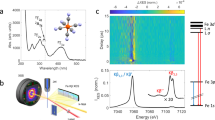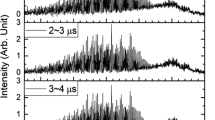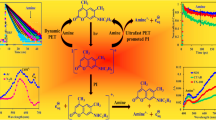Abstract
A method is reported for measuring the recombination efficiency of secondary geminate radical cage pairs. The procedure involves measuring the recombination efficiency for primary geminate recombination (Fc1) using pump-probe laser methods and measuring the “apparent” (or net) recombination efficiency (FcP) for all geminate pairs (primary and secondary) using steady-state irradiation methods. A mathematical relationship between FcP, Fc1, and Fc2 (where Fc2 is the recombination efficiency for secondary geminate recombination) is derived and demonstrated using the photolysis reactions of the [(CpR)Mo(CO)3]2 molecules, where CpR = η5-C5H4CH3 and η5-C5H4(CH2)2C(O)NCH3(CH2)nCH3 (n = 3, 8, 13, 18). As an example of the results obtained using the new method, it was found that Fc1 = 0.43 and Fc2 = 0.68 for the molecule with CpR = η5-C5H4CH2CH2N(CH3)C(O)(CH2)18CH3. The value of Fc2 decreased as the side-chain on the Cp ring got shorter; Fc2 is equal to 0.0 for the molecules with n = 3 and for CpR = η5-C5H4CH3. It is hypothesized that a longer side-chain prevents facile diffusion of the radicals out of the secondary cage, whereas the smaller side-chains permit more facile diffusion apart of the radicals. A general conclusion is that the reactions of large radicals in particular may be especially impacted by secondary geminate cage recombination.
Similar content being viewed by others
References
J. P. Lorand, The Cage Effect, Prog. Inorg. Chem., 1972, 17, 207–325.
S. A. Rice, Comprehensive Chemical Kinetics, Elsevier, Amsterdam, 1985.
J. L. Male, B. E. Lindfors, K. J. Covert and D. R. Tyler, The Effect of Radical Size and Mass on the Cage Recombination Efficiency of Photochemically Generated Radical Cage Pairs, J. Am. Chem. Soc., 1998, 120, 13176–13186.
P. Bosch, J. L. Mateo and J. Serrano, 1-Heptene, 3-heptenes and cumene as model compounds of SBS block copolymers. Study of their photoreactions in the presence of photoinitiators of polymerization, J. Photochem. Photobiol., A, 1997, 103, 177–184.
J. B. L. De Kock, A. M. Van Herk and A. L. German, Bimolecular free-radical termination at low conversion, J. Macromol. Sci., Part C: Polym. Rev., 2001, C41, 199–252.
H. Knoll, W. J. G. De Lange, H. Hennig, D. J. Stufkens and A. Oskam, Photochemical and thermal disproportionation of [(CO)4CoM(CO)3(LL)] (M = Mn, Re; LL = 2,2′-bipyridine, 2-pyridinecarboxaldehyde N-isopropylimine) complexes, J. Organomet. Chem., 1992, 430, 123–132.
H. K. Van Dijk, J. Van der Haar, D. J. Stufkens and A. Oskam, Metal to ligand charge-transfer photochemistry of metal-metal-bonded complexes. 7. Photochemistry of (CO)4CoM(CO)3(bpy) (M = Mn, Re; bpy = 2,2′-bipyridine): photocatalytic disproportionation of the manganese complex in the presence of PR3, Inorg. Chem., 1989, 28, 75–81.
W. B. Lott, A. M. Chagovetz and C. B. Grissom, Alkyl Radical Geometry Controls Geminate Cage Recombination in Alkylcobalamins, J. Am. Chem. Soc., 1995, 117, 12194–12201.
A. G. Cole, L. M. Yoder, J. J. Shiang, N. A. Anderson, L. A. Walker, II, M. M. Banaszak Holl and R. J. Sension, Time-Resolved Spectroscopic Studies of B12 Coenzymes: A Comparison of the Primary Photolysis Mechanism in Methyl-, Ethyl-, n-Propyl-, and 5′-Deoxyadenosylcobalamin, J. Am. Chem. Soc., 2002, 124, 434–441.
L. M. Yoder, A. G. Cole, L. A. Walker, II and R. J. Sension, Time-resolved spectroscopic studies of B12 coenzymes: Influence of solvent on the photolysis of adenosylcobalamin, J. Phys. Chem. B, 2001, 105, 12180–12188.
T. G. Grogan, N. Bag, T. G. Traylor and D. Magde, Picosecond Reaction of Picket Fence Heme with O2 and CO: Geminate Recombination in the Solvent Cage, J. Phys. Chem., 1994, 98, 13791–13796.
E. E. Scott, Q. H. Gibson and J. S. Olson, Mapping the pathways for O2 entry into and exit from myoglobin, J. Biol. Chem., 2001, 276, 5177–5188.
N. J. Turro, X. -G. Lei, W. Li, Z. Liu, A. McDermott, M. F. Ottaviani and L. Abrams, Photochemical and Magnetic Resonance Investigations of the Supramolecular Structure and Dynamics of Molecules and Reactive Radicals on the External and Internal Surface of MFI Zeolites, J. Am. Chem. Soc., 2000, 122, 11649–11659.
J. Sivaguru, A. Natarajan, L. S. Kaanumalle, J. Shailaja, S. Uppili, A. Joy and V. Ramamurthy, Asymmetric Photoreactions within Zeolites: Role of Confinement and Alkali Metal Ions, Acc. Chem. Res., 2003, 36, 509–521.
C. F. Melius and M. C. Piqueras, Initial reaction steps in the condensed-phase decomposition of propellants, Proc. Combust. Inst., 2002, 29, 2863–2871.
J. Xu and R. G. Weiss, Reaction cavities of liquid and solid phases of a long n-alkane, n-nonadecane, as probed by the regio- and stereo-chemical fates of two singlet radical pairs, Photochem. Photobiol. Sci., 2005, 4, 210–215.
S. Goldstein and G. Czapski, Viscosity Effects on the Reaction of Peroxynitrite with CO2: Evidence for Radical Formation in a Solvent Cage, J. Am. Chem. Soc., 1999, 121, 2444–2447.
J. M. Tanko, N. K. Suleman and B. Fletcher, Viscosity-Dependent Behavior of Geminate Caged-Pairs in Supercritical Fluid Solvent, J. Am. Chem. Soc., 1996, 118, 11958–11959.
J. Guillet, Photochemistry and molecular motion in solid amorphous polymers, Adv. Photochem., 1988, 14, 91–133.
M. Okamoto and F. Tanaka, Solvent and Pressure Effects on Quenching by Oxygen of 9,10-Dimethylanthracene Fluorescence in Liquid n-Alkanes: A Study on Solvent Cage Effects, J. Phys. Chem. A, 2006, 110, 10601–10606.
T. Koenig and R. G. Finke, The cage effect and apparent activation parameters for bond homolysis, J. Am. Chem. Soc., 1988, 110, 2657–2658.
J. Farias de Lima, A. K. Nakano and N. Y. M. Iha, Solvent cage effects on the ligand field photochemistry of the cyanoferrate(II) complexes, Inorg. Chem., 1999, 38, 403–405.
N. J. Turro and B. Kraeutler, Magnetic field and magnetic isotope effects in organic photochemical reactions. A novel probe of reaction mechanisms and a method for enrichment of magnetic isotopes, Acc. Chem. Res., 1980, 13, 369–377.
R. Kaptein, Chemically induced dynamic nuclear polarization: theory and applications in mechanistic chemistry, Advances in Free-Radical Chemistry (London), 1975, 5, 319–380.
A. Rembaum and M. Szwarc, O-O bond dissociation energies in propionyl and butyryl peroxides, J. Chem. Phys., 1955, 23, 909–913.
D. D. Tanner, H. Oumar-Mahamat, C. P. Meintzer, E. C. Tsai, T. T. Lu and D. Yang, Viscosity-dependent cage reactions. Multiple substitutions in radical-chain chlorinations, J. Am. Chem. Soc., 1991, 113, 5397–5402.
R. M. Noyes, Tests of solution models by quantum yields for dissociation, Z. Elektrochem. Angew. Phys. Chem., 1960, 64, 153–156.
K. Tomooka, H. Yamamoto and T. Nakai, Stereoselective synthesis of highly functionalized C-glycosides based on acetal [1,2] and [1,4] Wittig rearrangements, Angew. Chem., Int. Ed. Engl., 2000, 39, 4500–4502.
C. J. Jenks, A. Paul, L. A. Smoliar and B. E. Bent, Effects of surface defects and coadsorbed iodine on the chemistry of alkyl groups on copper surfaces: evidence for a cage effect, J. Phys. Chem., 1994, 98, 572–578.
A. C. Buchanan, III, P. F. Britt and K. B. Thomas, Radical Chemistry under Diffusional Constraints: Impact of Spacer Molecules on the Thermolysis of Surface-Immobilized Bibenzyl, Energy Fuels, 1998, 12, 649–659.
A. Kanaev, L. Museur, F. Edery, T. Laarmann and T. Moller, Cage effect for the photodissociation of H2O molecules in argon clusters embedded inside neon clusters, J. Chem. Phys., 2002, 117, 9423–9429.
V. Vorsa, S. Nandi, P. J. Campagnola, M. Larsson and W. C. Lineberger, Recombination dynamics of photodissociated I2− in size selected Ar and CO2 clusters, J. Chem. Phys., 1997, 106, 1402–1410.
U. Bhattacharjee, C. A. Chesta and R. G. Weiss, Temperature-dependent cage effects from triplet radical pairs generated upon irradiation of 1-(4-methylphenyl)-3-phenyl-2-propanone in polyethylene films, Photochem. Photobiol. Sci., 2004, 3, 287–295.
J. Franck and E. Rabinowitsch, Free radicals and the photochemistry of solutions, Trans. Faraday Soc., 1934, 30, 120–131.
E. Schutte, T. J. R. Weakley and D. R. Tyler, Radical Cage Effects in the Photochemical Degradation of Polymers: Effect of Radical Size and Mass on the Cage Recombination Efficiency of Radical Cage Pairs Generated Photochemically from the (CpCH2CH2N(CH3)C(O)(CH2nCH32Mo2(CO)6 (n = 3, 8, 18) Complexes, J. Am. Chem. Soc., 2003, 125, 10319–10326.
J. D. Harris, A. B. Oelkers and D. R. Tyler, The Solvent Cage Effect: Is There a Spin Barrier to Recombination of Transition Metal Radicals?, J. Am. Chem. Soc., 2007, 129, 6255–6262.
J. D. Harris, A. B. Oelkers and D. R. Tyler, Microviscosity and wavelength effects on radical cage pair recombination, J. Organomet. Chem., 2007, 692, 3261–3266.
N. Nodelman and J. C. Martin, Solvent cage effect in the photolysis of azomethane in aqueous alcohols and other media: a semiempirical correlation with macroscopic solvent parameters, J. Am. Chem. Soc., 1976, 98, 6597–6608.
A. B. Oelkers, L. F. Scatena and D. R. Tyler, Femtosecond pump-probe transient absorption study of the photolysis of [Cp′Mo(CO)3]2 (Cp′ = η5-C5H4CH3): Role of translational and totational diffusion in the radical cage effect, J. Phys. Chem. A, 2007, 111, 5353–5360.
D. A. Braden, E. E. Parrack and D. R. Tyler, Photochemical studies as a function of solvent viscosity. A new photochemical pathway in the reaction of (η5-C5H4Me)2Mo2(CO)6 with CCl4, Photochem. Photobiol. Sci., 2002, 1, 418–420.
R. M. Noyes, Kinetics of competitive processes when reactive fragments are produced in pairs, J. Am. Chem. Soc., 1955, 77, 2042–2045.
T. Koenig and H. Fischer, Cage effects, Free Radicals, 1973, 1, 157–189.
A. R. Manning, P. Hackett, R. Birdwhistell and P. Soye, Hexacarbonylbis(h5-cyclopentadienyl)dichromium, molybdenum, and tungsten and their analogs, M2(η5-C5H4R)2(CO)6 (M = Cr, Mo, and W; R = H, Me or PhCH2), Inorg. Synth., 1990, 28, 148–150.
D. A. Braden, E. E. Parrack and D. R. Tyler, Solvent cage effects. I. Effect, of radical mass and size on radical cage pair recombination efficiency. II. Is, geminate recombination of polar radicals sensitive to solvent polarity?, Coord. Chem. Rev., 2001, 211, 279–294.
J. L. Male, B. E. Lindfors, K. J. Covert and D. R. Tyler, Cage Effects in the Photochemical Degradation of Polymers. Studies of Model Complexes with Different Chain Lengths, Macromolecules, 1997, 30, 6404–6406.
A. B. Oelkers, E. J. Schutte and D. R. Tyler, Solvent Cage Effects: The Influence of Radical Mass and Volume on the Recombination Dynamics of Radical Cage Pairs Generated by Photolysis of [CpCH2CH2N(CH3)C(O)(CH2nCH3Mo(CO)3]2 (n = 3, 8, 13, 18) (Cp = η5-C5H4) Complexes, Photochem. Photobiol. Sci., 2008, 7, 228–234.
Author information
Authors and Affiliations
Corresponding author
Rights and permissions
About this article
Cite this article
Oelkers, A.B., Tyler, D.R. Radical cage effects: A method for measuring recombination efficiencies of secondary geminate radical cage pairs using pump-probe transient absorption methods. Photochem Photobiol Sci 7, 1386–1390 (2008). https://doi.org/10.1039/b804399j
Received:
Accepted:
Published:
Issue Date:
DOI: https://doi.org/10.1039/b804399j




